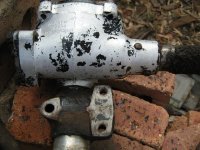germanmichel
Jedi Hopeful
Offline
Hello @ all,
like written in the subject line,does anyone know,how is the outer tube end(around of the steering shaft)fix in the steering box ?
I talk about a steering unit of a 1960/BT7. For me it looks like it was... a tight fit. But now it have play and it is easy to remove. On the outside diameter of the tube it is tin lead solder, i think it is not original. So what is the original best solution to get it fix and sealed ? No manual show this area. I mean the area under the item bubble 5
https://www.limora.com/index/lang-1/lkz-1...oesserungtop=30
I think about different solutions : hard soldering , tight fit with expanding and turning the tube end, but what was the original solution ?
Thank you all from good old and cold Germany
Michel
like written in the subject line,does anyone know,how is the outer tube end(around of the steering shaft)fix in the steering box ?
I talk about a steering unit of a 1960/BT7. For me it looks like it was... a tight fit. But now it have play and it is easy to remove. On the outside diameter of the tube it is tin lead solder, i think it is not original. So what is the original best solution to get it fix and sealed ? No manual show this area. I mean the area under the item bubble 5
https://www.limora.com/index/lang-1/lkz-1...oesserungtop=30
I think about different solutions : hard soldering , tight fit with expanding and turning the tube end, but what was the original solution ?
Thank you all from good old and cold Germany
Michel

 Hi Guest!
Hi Guest!

 smilie in place of the real @
smilie in place of the real @
 Pretty Please - add it to our Events forum(s) and add to the calendar! >>
Pretty Please - add it to our Events forum(s) and add to the calendar! >> 

